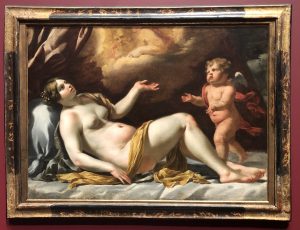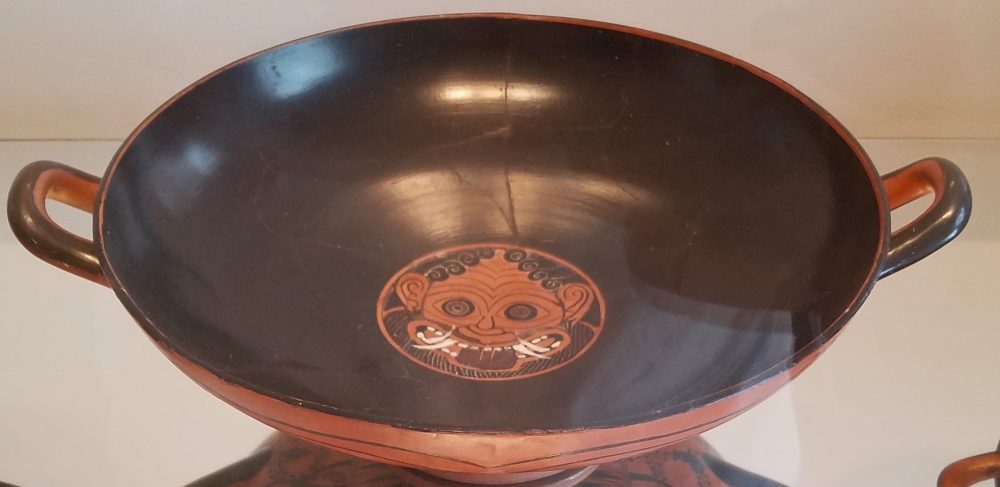 Artist: Jacques Blanchard (1600-1638), sometimes referred to as “French Titian”, is best known for his small religious and mythological paintings. Blanchard’s paintings deviated substantially from his contemporaries’; specifically, Blanchard’s painting style was softer and gentler with color and light than works of the Mannerist period that preceded him, and his choice of more sensual subject matter was unorthodox for the time period. But despite his deviance in style from many other famous contemporaries, the influence of the early baroque style on Blanchard’s painting is clearly observed in Danaë.
Artist: Jacques Blanchard (1600-1638), sometimes referred to as “French Titian”, is best known for his small religious and mythological paintings. Blanchard’s paintings deviated substantially from his contemporaries’; specifically, Blanchard’s painting style was softer and gentler with color and light than works of the Mannerist period that preceded him, and his choice of more sensual subject matter was unorthodox for the time period. But despite his deviance in style from many other famous contemporaries, the influence of the early baroque style on Blanchard’s painting is clearly observed in Danaë.
Date: Danaë was completed in the 1620s, 20 years into the start of the Baroque artistic period in Europe.
Location on Campus: The painting is housed in the Suida-Manning collection of the Blanton Museum of Art. Danaë one of the 50 pieces from the collection that is a part of Blanton’s permanent exhibition.
Acquisition: The painting was acquired by the University in 1998, along with the other 250 European paintings, 400 drawings, and 20 sculptures of the $33 million Suida-Manning Collection.
Description: The painting is a 36 3/4 in. x 50 9/16 in oil painting on canvas. Danaë is a vivid depiction of the mythological scene in which the Danaë, mother of the Greek hero Perseus, first encounters the enraptured and infatuated Jupiter.
One of the more striking artistic elements employed in the painting that was characteristic of baroque art is Blanchard’s use of chiaroscuro, or contrast between light and dark in order to highlight the central figures in the painting. In this image, Danaë’s fair skin is contrasted with a dark background, which is interrupted only by the glowing image of Jupiter. This serves to help the viewer focus their attention initially on the beauty of Danaë, allowing recognition of the subtleties of the painting to be registered later. In addition, one of baroque art’s central tenants was painting highly emotional scenes in order to appeal to the pathos of the viewer in a particular way; in this painting, Blanchard seems to emphasize Danaë’s confusion at the presence of Zeus more than any other emotion. Present also in the painting is a depiction of Cupid, or Eros, helping the reader understand that Jupiter’ admiration is of a sexual nature.
The Greek myth of Perseus and his strange birth may explain Danaë’s expression of confusion in this painting. According to Pherecydes’ The Histories and Apollodorus’ Library, Danaë’s father, Acrisios, had concern about fathering a male child and consulted the oracle for answers. There, the god Pytho informed Acrisios that his daughter Danaë would father a child who would ultimately kill him. In order to prevent his own fate at the hands of his grandson, he constructed an underground bronze chamber in his courtyard and kept Danaë inside as prisoner so that no man could woo and wed her. However, Acrisios’ attempts at isolating the beautiful Danaë failed when Zeus caught sight of Danaë. Zeus fell in love with her, and, turning himself into a shower of gold, rained down through the thatched roof, wooed her, and impregnated her. Ovid, a later Roman poet, retold the story briefly in book 4 of Metamorphoses, changing Danaë’s prison from an underground bronze chamber into a tower. Nonetheless, it is likely that Blanchard was influenced by a classical Greek text such as Library or Histories, as these accounts provide the reader with the most vivid detail of the scene.
Because the whole purpose of Danaë’s isolation was to keep her away from men, it is only natural that she would be surprised at the presence of Zeus in her chamber. It is unclear in the image whether Danaë is underground or in a tower; however, given that Zeus is on a cloud, it is assumed that she is in a tower and Zeus is seeing her through the open window. As aforementioned, the presence of Eros, or Cupid, indicates that, characteristically, Zeus is infatuated and that he is about to sexually pursue Danaë. Contrary to descriptions in myth, however, Zeus is depicted not as a golden shower, but as a deity. This is likely to help the reader understand Zeus’ infatuation, as his facial expression of admiration is a key indication to viewer of his intentions in Danaë’s chamber. Danaë and Cupid’s open hands indicate that, though surprised and perhaps confused, Danaë was welcome to Zeus’ presence in her chamber. No part of myth indicates that Zeus forced himself on Danaë, and Blanchard emphasizes this by filling Danaë’s facial expression with wonder.
This painting is an excellent example of how Greek myths were adapted by European artists to fit the style of their period. Jacques Blanchard’s Danaë demonstrates how baroque art appropriated Greek myth while remaining true to the artistic style of the individual artist. The fact that paintings like this are owned by the University of Texas is a testament to the University’s commitment to displaying and giving students access to a wide variety of high-quality, cross-cultural works.
Bibliography
“A Work by Jacques Blanchard Identified in Austin.” A Work by Jacques Blanchard Identified in Austin – The Art Tribune. Accessed April 27, 2019. http://www.thearttribune.com/A-Work-by-Jacques-Blanchard.html.
“Baroque.” Grove Art. September 26, 2018. Accessed April 27, 2019. http://www.oxfordartonline.com/groveart/view/10.1093/gao/9781884446054.001.0001/oao-9781884446054-e-7000006459.
“Boundless Art History.” Lumen. Accessed April 27, 2019. https://courses.lumenlearning.com/boundless-arthistory/chapter/the-baroque-period/.
“Foundation to Transfer Full Ownership of Suida-Manning Collection to Blanton in 2016.” The Daily Texan. Accessed April 27, 2019. http://www.dailytexanonline.com/news/2013/04/29/foundation-to-transfer-full-ownership-of-suida-manning-collection-to-blanton-in-20-0.
“Jacques Blanchard.” Europeana Collections. Accessed April 27, 2019. https://www.europeana.eu/portal/en/explore/people/22973-jacques-blanchard.html.
Rose, H. J. Gods and Heroes of the Greeks: An Introduction to Greek Mythology. New York: New American, 1976.
“Suida-Manning Collection at the Blanton Museum.” The Magazine Antiques. January 26, 2017. Accessed April 27, 2019. http://www.themagazineantiques.com/article/old-masters-at-the-blanton/.
Trzaskoma, Stephen M., R. Scott Smith, Stephen Brunet, and Thomas G. Palaima. Anthology of Classical Myth: Primary Sources in Translation. Apollodorus, Library, 4.1-2.4.5; Pherecydes, from The Histories, 10 The Story of Danae (fr. 10 Fowler). Hackett.
Written by Sophia Bibb
